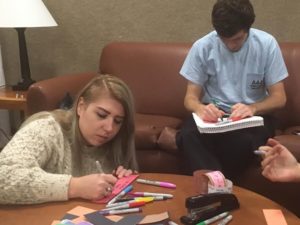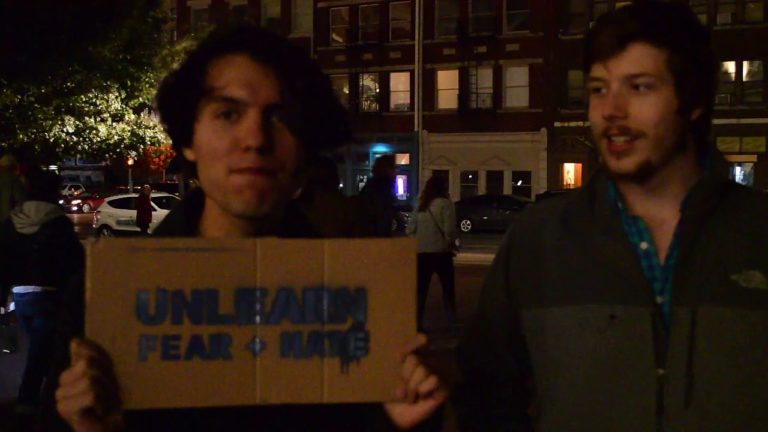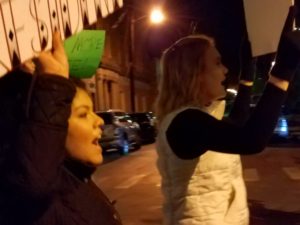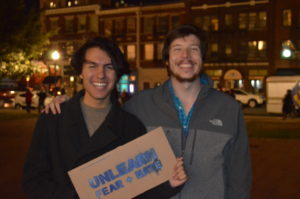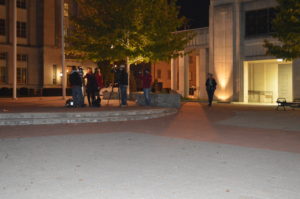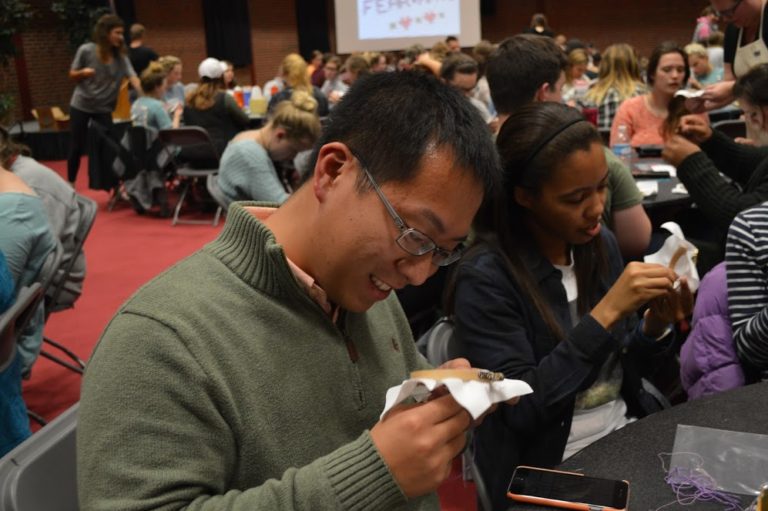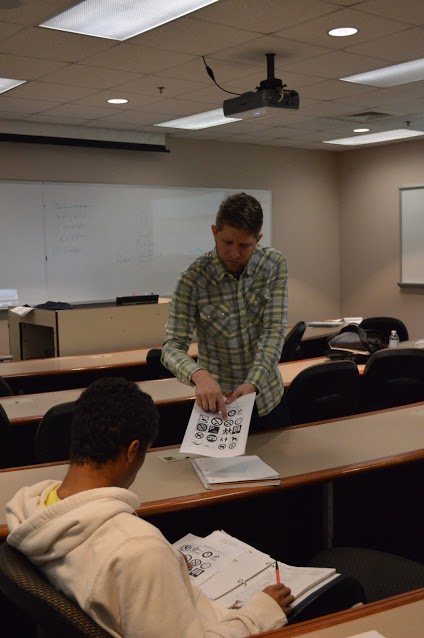The worst thing that theatre can be is boring. By any stretch of the imagination, the Transy production of Naomi Iizuka’s Anonymous is not boring. I saw the play twice, on its opening night and the night thereafter. As someone who has worked in most aspects of the theatre at various points, I had a lot of thought about what I saw, and I’d like to think I can bring those experiences to bear. I’d like to take this column and talk about what I thought was interesting about the play and the production, what did and didn’t work, and finally whether it’s worth your time to see for yourself.
Let’s start with what unequivocally worked. The set was gorgeous. The screens, placed in front of an elaborate series of platforms, were combined with a versatile lighting design to give the Little Theater a feeling of real depth. The stage itself was left mostly bare, giving the cast plenty of room to play in. The three chairs and movable table which compromised the movable set were used throughout the evening just enough to keep the playable space itself interesting. Similarly, the properties work was direct and functional– I mean this as the highest possible compliment; good props always enhance the action, and these did. The costumes, with a couple exceptions that I’ll discuss later, were also suited to the actors and the production. In short, the production values were quite good, and quite worth seeing. Stick around for a few minutes after the curtain and just take in the space; it’s worth it.
I did have some issues with Anonymous, however. I’ll look at two broad areas: the script itself, and some of the choices made by the production. I’ll then address a few of the thematic issues brought up by the play (by which I mean the combination of the script and production into a unified whole).
First, the script. The script is described by Ms. Iizuka as an adaptation of the Homeric Odyssey. This is, frankly, a misleading statement. Ms. Iizuka, in adapting Homer’s epic poem, has made several choices that take away from the overall wonderful theme of the play. In the Odyssey, Odysseus is a fantastically clever character, alive and active, always firmly at the center of the narrative, constantly scheming and plotting and generally fascinating audiences. In Anon(ymous), Odysseus is literally ‘Anon’, short for Anonymous. He is passive, listlessly carried along from one scene to another by a litany of secondary characters. This is accomplished in spite of a truly heroic acting effort by Aaron Botts. In the Odyssey, Odysseus carries himself from place to place by his strong desire to return to his home, his Ithaca, and his wife Penelope. However, in “Anon(ymous)”, Anon is carried by other from place to place with little desire of his own. He does not know what he wants, who he is, or even where his home is. Losing his sense of home as a refugee, he has lost his identity. Although this loss of identity may be common for a refugee, it is nothing like the emotions Odysseus felt during his travels.
This destruction of the characters Ms. Iizuka is purporting to adapt does not stop there. Penelope, who in the Homeric telling is the endlessly clever political genius and wife of Odysseus is here transformed into a meek and put-upon object of a lecherous factory owner’s affections. This is a poor degradation of a woman who, in the original, managed to keep several dozen violence-prone and heavily armed men peaceful and docile for twenty years. Further, Penelope (in Anon(ymous) re-nicknamed Penny) is no longer Odysseus’s wife but Anon’s mother, even as she remains the ostensible object of the Hero’s quest. This shift from wife to mother gave the whole enterprise a rather odd tinge; it makes the hero more similar to Oedipus than Odysseus.
Relatedly, the characters of Telemachus and Mentor (Athena’s alter ego) are excised completely, reducing our core cast to three– Anonymous, Penny, and the goddess Athena. She changes most drastically under Ms. Iizuka’s pen; Athena is transformed from a transcendent being whose very presence creates real awe in everyone involved, to an occasional side character who offers platitudes and cliches in a passive and uninterested voice. She is not, in other words, presented as remotely divine or slightly otherworldly, no matter how many times she reminds us she is a goddess. She comes across as entirely mundane.
I don’t want to imply that all the adaptation choices didn’t work. The changing of Penelope’s suitors to lechers and from kings to senators and factory owners was both dramatically effective in establishing each character’s relation to each other, and in keeping their scenes interesting. Further, it allows the script to highlight the ever present but often overlooked pervasiveness of sexual assault that is inflicted on refugee women. It was a simple and effective change; ditto for the changing of the cyclops to a man with an eyepatch. The change was simple, direct, effective. Ditto again to the changing of the Phaeacians to a Bangladeshi (or at least from the Indian subcontinent) family also works to keep the basic story while updating the details. And the characterization of Calypso as a ‘spoiled, basic white girl’ is pitch-perfect.
This brings us to production choices. Again, there’s much to admire. Many of the performances, including especially Anon/Odysseus, are effective and powerful. I’d like to especially note the performances of Aaron Botts, JD Lovell, Brayden Bergman, Katie Brewer-Calvert, and Mara Merchant as particularly dedicated.
But there are also some issues I have to admit I had with the production. I’ll start from the end and work my way backwards. The climax is, to be blunt, ineffective. It’s unintentionally hilarious to watch two people fight with a bolt of cloth and a clothing iron as their weapons of choice. It simply distracts us from the action and the emotional thrust of the piece by presenting us with a ridiculous spectacle. Similarly, a massively and unnecessarily ornate bird costume rendered ridiculous an otherwise effective scene between Odysseus/Anonymous and the Cyclops character. And again, it is Athena who suffers most. The goddess who should be a figure of immense power is rather difficult to take seriously when she’s wearing light-up kicks. Choices like these distract an audience (or this audience member, anyway) from the plot, theme, and emotional impact of the play.
This brings me to what is by far the largest issue I had when I saw this play. The cast was overwhelmingly white. Now, while I’m not exactly a fan of diversity quotas (they strike me as an ultimately misguided solution to a real problem), I think it is undeniable that the veritable luminescence of this cast, in this play, was a problem.
When I say I had a problem with the casting, I’m really talking about two interrelated problems. I’ll tackle them one at a time. The first problem is one of appropriateness. The aforementioned Bangladeshi family was two-thirds comprised of two white women in wigs of questionable veracity. The women themselves (Mollie LaFavers and Haberlin Roberts) gave perfectly fine performances, but it is flat out distracting to the point where it is virtually impossible to focus when this obviously white woman are being called Nasreen and Ritu. It simply destroys the verisimilitude of the world of the play. Instead of thinking about what’s going on onstage, I’m thinking about how this is obviously not right. The choice to produce the play with an overwhelmingly white cast abrogates the suspension of disbelief required to buy into the play. This question of appropriateness, on its own, might not normally be enough to distract me. But add in the second problem and it is certainly enough.
The second problem with having a mostly white cast is one of simple factual accuracy. The play claims it is about, (and is marketed as being about) the worldwide refugee crisis. The majority of the world’s current refugees are from Syria, and Afghanistan, and Somalia and the DRC and Iraq and Central and South America (this from UN Statistics). Bluntly, those are not places known for their large populations of white peoples. Any play that wants to seriously address the current refugee crisis, as this play purports to, therefore has to, as a matter of honesty, reflect the composition of the people in crisis. The casting of this play did not.
And the fact of the matter is that it really does matter who you put up on stage. If you want to, as this production seems to, build empathy for the people dispossessed from their homes, fleeing from horrific violence of a kind and scale that’s unimaginable here in the West, and who have nothing and have no powerful voice to speak for them, then you have to show your audience what they look like. If you cannot do that, then choose another one of the thousands of plays in the Western canon to produce. Nobody will begrudge you a good Christopher Durang, David Lindsey-Abaire, or Yasmina Reza play. Presenting a whitewashed production does a disservice to the audience, to the cast and theater, and to the very people it wants to advocate for.
It makes it very difficult to take seriously the segments where the cast en masse recites the litany of horrors facing refugees– extreme poverty, dangerous living conditions, constant fear of assault and death. It came off to me as self-righteous, as preachy, and as fundamentally out of touch. So what could be a powerful moment of human empathy is utterly undercut by a lack of accuracy.
The basic fact is that the current refugee crisis has affected Arab, African, and Asian peoples most severely. The crux of the refugee crisis is that people are forced from their homes; by whitewashing out literally what those people look like, the actual places and actual homes of the people affected are effectively erased.
So if you want to tell a story about the refugee crisis, focus on the stories of Arab, African, and Asian peoples. You can make a plausible case that creating a more multiracial cast lends a universalist tinge, but that is not what’s happened here. There is not a universalist case made by an overwhelmingly white cast, merely a pan-European one. It’s a form of erasure that wipes out the stories of the very peoples most affected by the story you’re attempting to tell. I find it nothing more than artistic dishonesty. I’m going to be honest, it was deeply uncomfortable for me to watch.
But some discomfort every now and then can be a good thing. And certainly, this should be an uncomfortable topic to address. It’s an earnest, if sometimes diluted, attempt to provide an empathetic look at the peoples caught up in the refugee crisis. So you should certainly go see this play. It’s definitely not boring.

